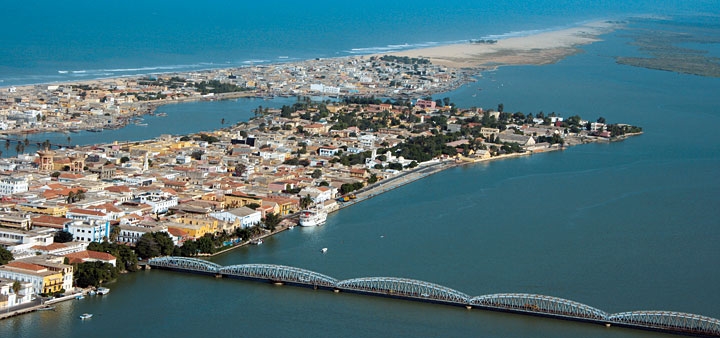
Key Takeaways:
-
Saint-Louis offers a rare blend of colonial history, vibrant local art, and peaceful natural escapes all year round.
-
Whether you’re exploring UNESCO-listed architecture or spotting birds in a national park, this coastal city surprises at every turn.
-
With music festivals, French-African fusion cuisine, and riverfront walks, Saint-Louis is Senegal’s most soulful and scenic destination.
Once the capital of French West Africa, Saint-Louis is a city like no other — draped in colonial-era elegance and powered by rich cultural traditions. Located on the northwest coast of Senegal where the Senegal River meets the Atlantic Ocean, this UNESCO World Heritage city blends French architecture, African rhythm, and a unique island-meets-mainland layout. Nicknamed the “Venice of Africa,” its charm lies in the details — colorful balconies, quiet alleyways, and lantern-lit nights.
People love Saint-Louis for its timeless beauty, its jazz, and its feeling of being both laid-back and deeply alive. Whether you’re watching fishermen haul in nets, browsing local art studios, or dancing in a pop-up parade, the city pulses with culture year-round. It’s a destination where history breathes through the walls, and every day invites discovery.
Table of Contents
-
Walk Across the Faidherbe Bridge
-
Discover the Saint-Louis Jazz Festival
-
Explore Langue de Barbarie National Park
-
Stroll the Island of Saint-Louis’ Historic Quarters
-
Visit the Musée de la Photographie de Saint-Louis
-
Attend the Fanals Festival of Light
-
Take a Pirogue Tour on the Senegal River
-
Relax at Hydrobase Beach
-
Tour the Fishermen’s Quarter of Guet Ndar
-
Explore the Djoudj National Bird Sanctuary
1. Walk Across the Faidherbe Bridge
The Faidherbe Bridge is more than just a crossing point — it’s a symbol of Saint-Louis and a feat of 19th-century engineering. This iron structure connects the mainland to the historic island city and is believed to have been designed by Gustave Eiffel’s firm. Walking across gives you stunning views of the Senegal River and the pastel-hued colonial buildings lining the water.
The bridge is open to both vehicles and pedestrians and is especially beautiful at sunrise and sunset. Local artists often sell paintings or perform music near its base, adding an extra touch of vibrancy. Every trip to the island starts with this walk, and it’s the perfect way to transition from the modern world to the slow rhythm of Saint-Louis.
2. Discover the Saint-Louis Jazz Festival
One of Africa’s most celebrated music events, the Saint-Louis Jazz Festival draws global performers and jazz lovers to the city every May. The streets fill with sound — not just classic jazz, but Afrobeat, funk, soul, and fusion — turning every corner into a stage. Free public concerts blend with ticketed performances in grand colonial halls, creating a full week of unforgettable musical moments.
Even outside festival dates, the city’s connection to jazz can be felt in its cafés, record shops, and impromptu sidewalk sessions. Visiting during this time means dancing with locals under the stars and soaking in global rhythms on a West African stage. It’s one of the best reasons to time your visit to this cultural capital.
3. Explore Langue de Barbarie National Park
Just a short drive from downtown Saint-Louis, the Langue de Barbarie National Park is a narrow, sandy peninsula that offers a unique meeting point of ocean, river, and wildlife. The park is home to migratory birds, turtles, and lush mangroves, best explored by pirogue (traditional boat) or on foot. It’s especially peaceful at dawn when the only sounds are birdcalls and waves.
The park is open year-round and ideal for birdwatching, nature photography, or simply escaping the city for a few hours. Local guides are available and often include cultural insights into fishing and conservation efforts. Whether you’re seeking serenity or a soft adventure, Langue de Barbarie delivers stunning scenery and ecological richness.
4. Stroll the Island of Saint-Louis’ Historic Quarters
The heart of Saint-Louis lies on its island, a grid of narrow streets lined with mustard-yellow and salmon-pink colonial houses. Many of these buildings date back to the 18th and 19th centuries and now house galleries, hotels, or family homes. Walking here is like stepping into a living museum — balconies draped in bougainvillea, horse-drawn carts clicking by, and the scent of thieboudienne wafting from kitchens.
The ambiance changes with the time of day — morning light for photography, mid-day for café hopping, and golden hour for riverside drinks. Guided walking tours help you uncover the stories of merchants, governors, and artists who shaped this city. It’s a place to wander slowly and soak in details at every turn.
5. Visit the Musée de la Photographie de Saint-Louis
Housed in a beautifully restored colonial building, the Musée de la Photographie celebrates the city’s deep ties to visual storytelling. Exhibits range from archival images of Senegal’s independence era to modern street photography capturing the pulse of daily life. It’s a quiet, thoughtful space that showcases how Saint-Louis has always stood at the crossroads of culture and creativity.
The museum is open year-round and often hosts film screenings, artist talks, and temporary exhibits from across the African continent. Photography lovers will appreciate the historical depth, while casual visitors will be moved by the emotional power of the images. It’s one of the city’s best cultural stops and a meaningful window into Senegalese identity.
6. Attend the Fanals Festival of Light
Every December, Saint-Louis glows with lanterns, parades, and storytelling during the Fanals Festival — one of the city’s most treasured traditions. Rooted in colonial and local customs, this celebration features children and adults parading through the streets with elaborately handcrafted paper lanterns shaped like stars, houses, or animals. The effect is magical, casting a golden glow on the island’s historic streets.
Fanals represents more than just lights — it’s about community, memory, and intergenerational creativity. Locals prepare for weeks, and many neighborhoods compete in friendly fanal design contests. Whether you’re a participant or an observer, this event gives you a heartwarming and visually stunning glimpse into Saint-Louisian identity and holiday spirit.
7. Take a Pirogue Tour on the Senegal River
One of the most peaceful and picturesque ways to explore Saint-Louis is by taking a pirogue — a traditional wooden canoe — along the Senegal River. These guided tours reveal the layered geography of the city, from colonial facades to mangroves, riverbanks, and bird habitats. The slow pace invites you to appreciate the rhythm of life in a city surrounded by water.
You can book a short one-hour ride or longer excursions that include nearby nature reserves or fishing villages. Sunrise and sunset are especially stunning times to go, as golden light reflects off the water and local fishermen return with their day’s catch. It’s a gentle, meditative journey that offers insight into both nature and culture.
8. Relax at Hydrobase Beach
Hydrobase Beach, located just south of Saint-Louis’ island center, is a wide, sandy stretch where the Atlantic meets the edge of the city. It’s ideal for a relaxed afternoon of swimming, sunbathing, or enjoying fresh seafood with ocean views. The beach has a rugged, natural beauty, with occasional camel rides, seashell markets, and horseback riders adding to the scene.
While the surf can be strong, the area is generally safe and clean, especially near hotels and beach clubs that offer loungers, snacks, and shade. In the evenings, bonfires and music sometimes light up the shore, especially on weekends. Whether you’re looking to unplug or people-watch, Hydrobase is a year-round beach break without the crowds.
9. Tour the Fishermen’s Quarter of Guet Ndar
Guet Ndar is one of the oldest and most culturally rich neighborhoods in Saint-Louis, home to thousands of Lebou fishermen and their families. The streets are narrow and bustling with life — fish drying on racks, kids playing football, and women preparing meals in colorful dresses. It’s one of the best places to witness the pulse of daily life in the city.
You can visit early in the morning to watch the fishermen return with their catch, or explore in the late afternoon when the sun paints the houses in warm hues. Be respectful — this is a residential area — but most locals are warm and welcoming, especially if you’re curious and kind. It’s an eye-opening way to understand Saint-Louis beyond the colonial facades.
10. Explore the Djoudj National Bird Sanctuary
Just a 90-minute drive from Saint-Louis lies the Djoudj National Bird Sanctuary, a UNESCO-listed wetland that’s home to over 1.5 million birds. It’s one of the most important birdwatching spots in the world, particularly for pelicans, flamingos, herons, and migratory species from Europe and Central Asia. Between November and April, the sanctuary becomes a living, flapping mosaic of feathers and flight.
Boat tours take you deep into the reserve, offering front-row views of nesting colonies and crocodiles lounging along the riverbanks. The landscape is serene and otherworldly, especially at sunrise. Whether you’re a birder or not, Djoudj is one of the most awe-inspiring natural experiences Senegal has to offer — and well worth the detour.
What to do if you have kids?
Saint-Louis is a great destination for families, with gentle riverfront walks, spacious beaches, and cultural sites that spark curiosity. Kids will love riding pirogues, exploring the castle-like Turreted Water Tower, or watching lanterns during the Fanals Festival. The Langue de Barbarie and Djoudj parks offer nature up-close, while local cafés often serve kid-friendly meals. Bring snacks, water, and sun protection, and you’ll find the city very manageable for little explorers.
Where can I find free events in Saint-Louis Senegal taking place this weekend?
To find the best free events in Saint-Louis — from local markets and live music to cultural parades or open-air cinema nights — check out https://planmyweekend.ai. Our AI-powered platform curates real-time happenings based on your location and interests, helping you uncover the city’s hidden gems without breaking the bank. Whether you’re a visitor or local, Plan My Weekend makes it easy to enjoy Saint-Louis to the fullest.
Final Thoughts on Planning a Trip to Saint-Louis
Saint-Louis is more than a postcard-perfect town — it’s a living archive of West African culture, resilience, and creativity. With its colonial architecture, soulful music, and dynamic daily life, the city invites you to slow down and savor the moment. Whether you’re drifting down the river, dancing at a jazz show, or strolling cobbled streets at dusk, Saint-Louis offers an experience that lingers long after you leave. It’s a destination where every season brings something beautiful — and every visit feels like coming home.
Author: Dejon Brooks
Dejon Brooks is an entrepreneur who founded Trend Watchers with his life savings. Aged 24, Dejon has turned Trend Watchers into a successful business. After reaching over 150M+ people on his personal accounts, he now spends his time growing Planmyweekend.ai


